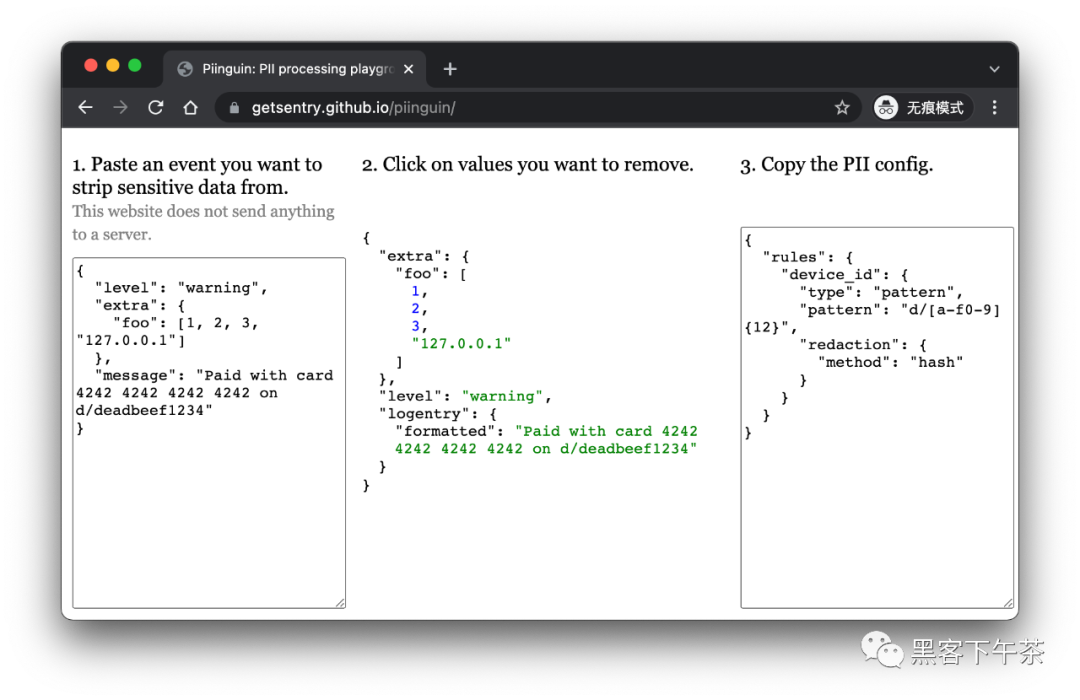Sentry 企业级数据安全解决方案 - Relay PII 和数据清理

本文档描述了一种我们希望最终对用户隐藏的配置格式。该页面仍然存在的唯一原因是当前 Relay 接受这种格式以替代常规数据清理设置。
以下文档探讨了 Relay 使用和执行的高级数据清理配置的语法和语义。有时,这也称为 PII 清理。
- https://github.com/getsentry/relay
- https://docs.sentry.io/product/data-management-settings/scrubbing/advanced-datascrubbing/
- Scrub personally identifiable information (PII)
一个基本的例子
假设您有一条异常消息,不幸的是,其中包含不应该存在的 IP 地址。你会写:
{
"applications": {
"$string": ["@ip:replace"]
}
}
它读作 “替换所有字符串中的所有 IP 地址”,或 "将 @ip:replace 应用于所有 $string 字段"。
@ip:replace 称为规则,$string 称为选择器。
内置规则
默认存在以下规则:
@ip:replace和@ip:hash用于替换IP地址。@imei:replace和@imei:hash用于替换IMEI。@mac:replace、@mac:mask和@mac:hash用于匹配MAC地址。@email:mask、@email:replace和@email:hash用于匹配email地址。@creditcard:mask、@creditcard:replace和@creditcard:hash用于匹配信用卡号码。@userpath:replace和@userpath:hash用于匹配本地路径(例如C:/Users/foo/)。@password:remove用于删除密码。在这种情况下,我们对字段的key进行pattern匹配,无论它是否包含password、credentials或类似的字符串。@anything:remove、@anything:replace和@anything:hash用于删除、替换或hash任何值。它本质上等同于通配符正则表达式,但它也比字符串匹配得多。
编写自己的规则
规则一般由两部分组成:
每个页面都带有示例。
通过将这些示例粘贴到 Piinguin 的 “PII 配置” 列并单击字段以获取建议来尝试这些示例。
交互式编辑
解决此问题的最简单方法是,如果您已经拥有来自某个 SDK 的原始 JSON payload。
转到我们的 PII 配置编辑器 Piinguin,然后:
- 粘贴到原始事件中
- 点击你想要消除的数据
- 粘贴其他有效负载并查看它们是否正常,如有必要,请转到步骤 2。
在对配置进行迭代后,将其粘贴回位于 .relay/projects/<PROJECT_ID>.json 的项目配置中
例如:
{
"publicKeys": [
{
"publicKey": "___PUBLIC_KEY___",
"isEnabled": true
}
],
"config": {
"allowedDomains": ["*"],
"piiConfig": {
"rules": {
"device_id": {
"type": "pattern",
"pattern": "d/[a-f0-9]{12}",
"redaction": {
"method": "hash"
}
}
},
"applications": {
"freeform": ["device_id"]
}
}
}
}
PII 规则类型
pattern-
自定义 Perl 风格的正则表达式 (PCRE)。
{ "rules": { "hash_device_id": { "type": "pattern", "pattern": "d/[a-f0-9]{12}", "redaction": { "method": "hash" } } }, "applications": { "$string": ["hash_device_id"] } } imei-
匹配 IMEI 或 IMEISV。
{ "rules": { "hash_imei": { "type": "imei", "redaction": { "method": "hash" } } }, "applications": { "$string": ["hash_imei"] } } mac-
匹配一个 MAC 地址。
{ "rules": { "hash_mac": { "type": "mac", "redaction": { "method": "hash" } } }, "applications": { "$string": ["hash_mac"] } } ip-
匹配任何 IP 地址。
{ "rules": { "hash_ip": { "type": "ip", "redaction": { "method": "hash" } } }, "applications": { "$string": ["hash_ip"] } } creditcard-
匹配信用卡号。
{ "rules": { "hash_cc": { "type": "creditcard", "redaction": { "method": "hash" } } }, "applications": { "$string": ["hash_cc"] } } userpath-
匹配本地路径(例如
C:/Users/foo/)。{ "rules": { "hash_userpath": { "type": "userpath", "redaction": { "method": "hash" } } }, "applications": { "$string": ["hash_userpath"] } } anything-
匹配任何值。这基本上等同于通配符正则表达式。
例如,要删除所有字符串:
{ "rules": { "remove_everything": { "type": "anything", "redaction": { "method": "remove" } } }, "applications": { "$string": ["remove_everything"] } } multiple-
将多个规则合二为一。这是一个析取 (
OR):有问题的字段必须只匹配一个规则来匹配组合规则,而不是全部。{ "rules": { "remove_ips_and_macs": { "type": "multiple", "rules": [ "@ip", "@mac" ], "hide_rule": false, // Hide the inner rules when showing which rules have been applied. Defaults to false. "redaction": { "method": "remove" } } }, "applications": { "$string": ["remove_ips_and_macs"] } } alias-
别名一个规则到另一个。这与
multiple相同,只是您只能包装一个规则。{ "rules": { "remove_ips": { "type": "multiple", "rule": "@ip", "hide_rule": false, // Hide the inner rule when showing which rules have been applied. Defaults to false. "redaction": { "method": "remove" } } }, "applications": { "$string": ["remove_ips"] } }
PII 编辑方法
remove-
删除整个字段。
Relay可以选择将其设置为null或完全删除它。{ "rules": { "remove_ip": { "type": "ip", "redaction": { "method": "remove" } } }, "applications": { "$string": ["remove_ip"] } } replace-
用
static string替换key。{ "rules": { "replace_ip": { "type": "ip", "redaction": { "method": "replace", "text": [censored]" } } }, "applications": { "$string": ["replace_ip"] } } - ###
mask -
用
"masking(掩码)"字符*替换匹配字符串的每个字符。与replace相比,它保留了原始字符串的长度。{ "rules": { "mask_ip": { "type": "ip", "redaction": { "method": "mask" } } }, "applications": { "$string": ["mask_ip"] } } - ###
hash -
用它自己的
hash版本替换字符串。相等的字符串将产生相同的hash值,因此,例如,如果您决定对用户ID进行散列处理而不是替换或删除它,您仍将获得受影响用户的准确计数。{ "rules": { "hash_ip": { "type": "ip", "redaction": { "method": "hash" } } } "applications": { "$string": ["mask_ip"] } }
PII 选择器
选择器允许您将规则限制在事件的某些部分。
这对于按变量/字段名称从事件中无条件删除某些数据很有用,但也可用于对真实数据进行保守的测试规则。
数据清理始终适用于原始事件负载。
请记住,UI 中的某些字段在 JSON schema 中的调用方式可能不同。
在查看事件时,应该始终存在一个名为 "JSON" 的链接,可让您查看数据清理器看到的内容。
例如,在 UI 中称为 "Additional Data" 的内容在事件负载中称为 extra。要删除名为 foo 的特定 key,您可以编写:
[Remove] [Anything] from [extra.foo]
另一个例子。Sentry 知道两种错误消息:异常消息和顶级日志消息。
以下是由 SDK 发送的此类事件负载(可从 UI 下载)的示例:
{
"logentry": {
"formatted": "Failed to roll out the dinglebop"
},
"exceptions": {
"values": [
{
"type": "ZeroDivisionError",
"value": "integer division or modulo by zero"
}
]
}
}
由于 "error message" 取自 exception 的 value,
而 "message" 取自 logentry,因此我们必须编写以下内容以将两者从事件中删除:
[Remove] [Anything] from [exception.value]
[Remove] [Anything] from [logentry.formatted]
布尔逻辑
您可以使用布尔逻辑组合选择器。
- 以
!为前缀来反转选择器。foo匹配 JSON keyfoo,而!foo匹配除foo之外的所有内容。 - 使用
&&构建连词 (AND),例如:foo && !extra.foo以匹配 keyfoo,除非在extra内部。 - 使用
||构建析取 (OR),例如:foo || bar匹配foo或bar。
通配符
**匹配所有子路径,因此foo.**匹配foo中的所有JSON键。*匹配单个路径项,因此foo.*匹配比foo低一级的所有JSON键。
值类型
使用以下内容按 JSON-type 选择子节:
$string匹配任何字符串值$number匹配任何整数或浮点值$datetime匹配事件中代表时间戳的任何字段$array匹配任何 JSON 数组值$object匹配任何 JSON 对象
使用以下方法选择 schema 的已知部分:
$exception匹配{"exception": {"values": [...]}}中的单个异常实例$stacktrace匹配一个堆栈跟踪实例$frame匹配一个帧$request匹配事件的HTTP请求上下文$user匹配事件的用户上下文$logentry(也适用于message属性)$thread匹配{"threads": {"values": [...]}}中的单个线程实例$breadcrumb匹配{"breadcrumbs": [...]}中的单个面包屑$span匹配一个 trace span$sdk匹配{"sdk": ...}中的 SDK 上下文
示例
-
删除
event.user:[Remove] [Anything] from [$user] -
删除所有帧局部变量:
[Remove] [Anything] from [$frame.vars]
转义特殊字符
如果要匹配的对象 key 包含空格或特殊字符,可以使用引号将其转义:
[Remove] [Anything] from [extra.'my special value']
这与 附加数据 中的 key my special value 相匹配。
要在引号内转义 '(单引号),请将其替换为 ''(两个引号):
[Remove] [Anything] from [extra.'my special '' value']
这与 附加数据 中的key my special ' value 值相匹配。



 浙公网安备 33010602011771号
浙公网安备 33010602011771号